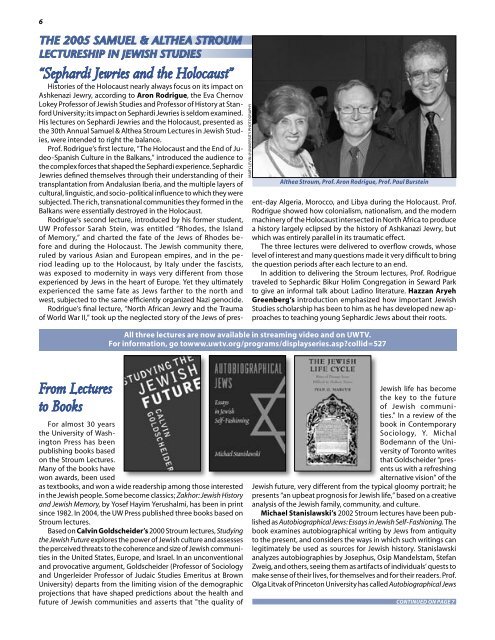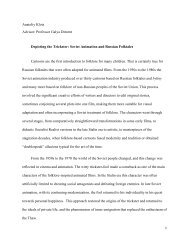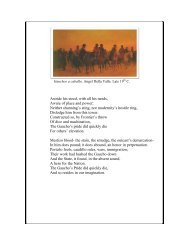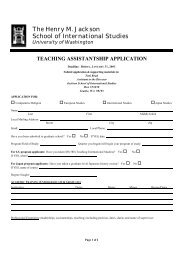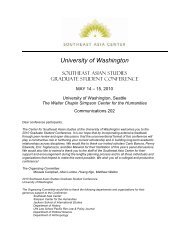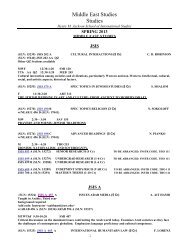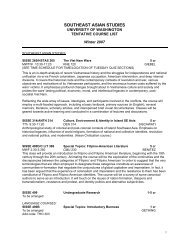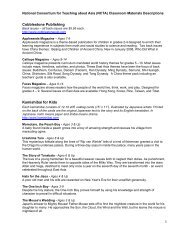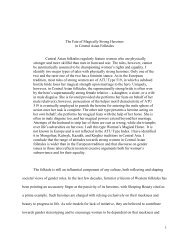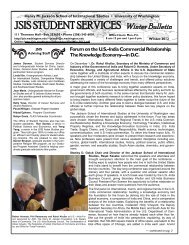js nl 05 9-25 final run! copy - Jackson School of International Studies ...
js nl 05 9-25 final run! copy - Jackson School of International Studies ...
js nl 05 9-25 final run! copy - Jackson School of International Studies ...
You also want an ePaper? Increase the reach of your titles
YUMPU automatically turns print PDFs into web optimized ePapers that Google loves.
6<br />
THE 20<strong>05</strong> SAMUEL & ALTHEA STROUM<br />
LECTURESHIP IN JEWISH STUDIES<br />
“Sephardi Jewries and the Holocaust”<br />
Histories <strong>of</strong> the Holocaust nearly always focus on its impact on<br />
Ashkenazi Jewry, according to Aron Rodrigue, the Eva Chernov<br />
Lokey Pr<strong>of</strong>essor <strong>of</strong> Jewish <strong>Studies</strong> and Pr<strong>of</strong>essor <strong>of</strong> History at Stanford<br />
University; its impact on Sephardi Jewries is seldom examined.<br />
His lectures on Sephardi Jewries and the Holocaust, presented as<br />
the 30th Annual Samuel & Althea Stroum Lectures in Jewish <strong>Studies</strong>,<br />
were intended to right the balance.<br />
Pr<strong>of</strong>. Rodrigue’s first lecture, “The Holocaust and the End <strong>of</strong> Judeo-Spanish<br />
Culture in the Balkans,” introduced the audience to<br />
the complex forces that shaped the Sephardi experience. Sephardic<br />
Jewries defined themselves through their understanding <strong>of</strong> their<br />
transplantation from Andalusian Iberia, and the multiple layers <strong>of</strong><br />
cultural, linguistic, and socio-political influence to which they were<br />
subjected. The rich, transnational communities they formed in the<br />
Balkans were essentially destroyed in the Holocaust.<br />
Rodrigue’s second lecture, introduced by his former student,<br />
UW Pr<strong>of</strong>essor Sarah Stein, was entitled “Rhodes, the Island<br />
<strong>of</strong> Memory,” and charted the fate <strong>of</strong> the Jews <strong>of</strong> Rhodes before<br />
and during the Holocaust. The Jewish community there,<br />
ruled by various Asian and European empires, and in the period<br />
leading up to the Holocaust, by Italy under the fascists,<br />
was exposed to modernity in ways very different from those<br />
experienced by Jews in the heart <strong>of</strong> Europe. Yet they ultimately<br />
experienced the same fate as Jews farther to the north and<br />
west, subjected to the same efficiently organized Nazi genocide.<br />
Rodrigue’s <strong>final</strong> lecture, “North African Jewry and the Trauma<br />
<strong>of</strong> World War II,” took up the neglected story <strong>of</strong> the Jews <strong>of</strong> pres-<br />
From Lectures<br />
to Books<br />
For almost 30 years<br />
the University <strong>of</strong> Washington<br />
Press has been<br />
publishing books based<br />
on the Stroum Lectures.<br />
Many <strong>of</strong> the books have<br />
won awards, been used<br />
as textbooks, and won a wide readership among those interested<br />
in the Jewish people. Some become classics; Zakhor: Jewish History<br />
and Jewish Memory, by Yosef Hayim Yerushalmi, has been in print<br />
since 1982. In 2004, the UW Press published three books based on<br />
Stroum lectures.<br />
Based on Calvin Goldscheider’s 2000 Stroum lectures, Studying<br />
the Jewish Future explores the power <strong>of</strong> Jewish culture and assesses<br />
the perceived threats to the coherence and size <strong>of</strong> Jewish communities<br />
in the United States, Europe, and Israel. In an unconventional<br />
and provocative argument, Goldscheider (Pr<strong>of</strong>essor <strong>of</strong> Sociology<br />
and Ungerleider Pr<strong>of</strong>essor <strong>of</strong> Judaic <strong>Studies</strong> Emeritus at Brown<br />
University) departs from the limiting vision <strong>of</strong> the demographic<br />
projections that have shaped predictions about the health and<br />
future <strong>of</strong> Jewish communities and asserts that "the quality <strong>of</strong><br />
MARY LEVIN @UNIVERSITY PHOTOGRAPHY<br />
Althea Stroum, Pr<strong>of</strong>. Aron Rodrigue, Pr<strong>of</strong>. Paul Burstein<br />
ent-day Algeria, Morocco, and Libya during the Holocaust. Pr<strong>of</strong>.<br />
Rodrigue showed how colonialism, nationalism, and the modern<br />
machinery <strong>of</strong> the Holocaust intersected in North Africa to produce<br />
a history largely eclipsed by the history <strong>of</strong> Ashkanazi Jewry, but<br />
which was entirely parallel in its traumatic effect.<br />
The three lectures were delivered to overflow crowds, whose<br />
level <strong>of</strong> interest and many questions made it very difficult to bring<br />
the question periods after each lecture to an end.<br />
In addition to delivering the Stroum lectures, Pr<strong>of</strong>. Rodrigue<br />
traveled to Sephardic Bikur Holim Congregation in Seward Park<br />
to give an informal talk about Ladino literature. Hazzan Aryeh<br />
Greenberg’s introduction emphasized how important Jewish<br />
<strong>Studies</strong> scholarship has been to him as he has developed new approaches<br />
to teaching young Sephardic Jews about their roots.<br />
All three lectures are now available in streaming video and on UWTV.<br />
For information, go towww.uwtv.org/programs/displayseries.asp?collid=527<br />
Jewish life has become<br />
the key to the future<br />
<strong>of</strong> Jewish communi -<br />
ties." In a review <strong>of</strong> the<br />
book in Contemporary<br />
Sociology, Y. Michal<br />
Bodemann <strong>of</strong> the University<br />
<strong>of</strong> Toronto writes<br />
that Goldscheider “presents<br />
us with a refreshing<br />
alternative vision” <strong>of</strong> the<br />
Jewish future, very different from the typical gloomy portrait; he<br />
presents “an upbeat prognosis for Jewish life,” based on a creative<br />
analysis <strong>of</strong> the Jewish family, community, and culture.<br />
Michael Stanislawski’s 2002 Stroum lectures have been published<br />
as Autobiographical Jews: Essays in Jewish Self-Fashioning. The<br />
book examines autobiographical writing by Jews from antiquity<br />
to the present, and considers the ways in which such writings can<br />
legitimately be used as sources for Jewish history. Stanislawski<br />
analyzes autobiographies by Josephus, Osip Mandelstam, Stefan<br />
Zweig, and others, seeing them as artifacts <strong>of</strong> individuals’ quests to<br />
make sense <strong>of</strong> their lives, for themselves and for their readers. Pr<strong>of</strong>.<br />
Olga Litvak <strong>of</strong> Princeton University has called Autobiographical Jews<br />
CONTINUED ON PAGE 7


